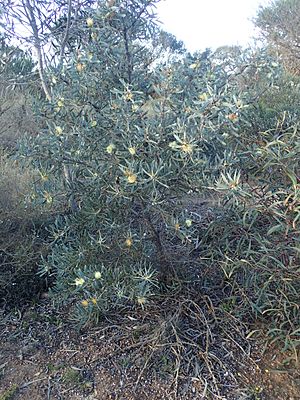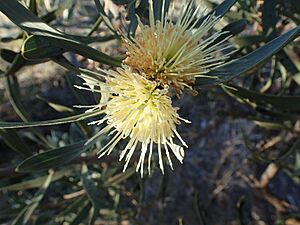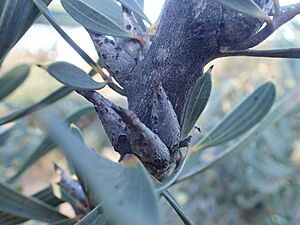Ashy facts for kids
Quick facts for kids Ashy |
|
|---|---|
 |
|
| Hakea cinerea growing north-east of Esperance | |
| Scientific classification | |
| Genus: |
Hakea
|
| Species: |
cinerea
|
 |
|
| Occurrence data from Australasian Virtual Herbarium | |
Hakea cinerea, often called the ashy hakea or grey hakea, is a type of shrub. It belongs to the plant family called Proteaceae. You can find it growing naturally along the south coast of Western Australia, especially in the Goldfields-Esperance area. This plant is quite beautiful and is often grown for its looks. It has creamy-white flowers that turn orange as they get older. Its leaves are a cool grey-green color, which contrasts nicely with the flowers.
Contents
What Does the Ashy Hakea Look Like?
The Hakea cinerea is a round, stiff shrub. It usually grows to be about 0.7 to 2.5 meters (2 to 8 feet) tall. Its branches grow upwards.
From August to November, this plant shows off its large, pretty flowers. They are creamy-white and yellow at first, then turn orange as they age. These flowers grow in groups where the leaves meet the stem. The small stalks that hold the flowers are called pedicels. They are smooth and about 4 to 6 millimeters long. The style, which is part of the flower, is about 22 to 23 millimeters long.
The leaves of the ashy hakea are stiff and a lovely blue-grey color. They are about 6 to 16 centimeters (2.4 to 6.3 inches) long and 8 to 18 millimeters (0.3 to 0.7 inches) wide. They get narrower towards a blunt tip. The leaves are yellow at their base and have three clear grey-green lines (veins) running along them. After the flowers, small, narrow fruits grow. They have a slightly rough surface and stand upright in groups of one to five. These fruits are about 2.2 to 2.5 centimeters (0.9 to 1 inch) long and 0.6 to 0.9 millimeters wide.
How Did It Get Its Name?
Naming the Ashy Hakea
The plant Hakea cinerea was first officially described in 1810. This was done by a botanist named Robert Brown. He published his description in a scientific paper called Transactions of the Linnean Society of London. The second part of its scientific name, cinerea, comes from a Latin word. Cinereus means "of ashes" or "ash-colored". This name was chosen because of the grey, ash-like color of the plant's leaves.
Where Does the Ashy Hakea Grow?
Hakea cinerea is found in Western Australia. It grows from a town called Ravensthorpe all the way to Esperance and Israelite Bay. It has also been seen at Point Culver, which is at the western end of the Great Australian Bight. This plant likes to grow in sunny spots with soil that drains well. It prefers deep sand in areas with heath (low-growing shrubs), gravelly soils, or low scrubland. It's a good plant for gardens because it can act as a windbreak and provides a home for wildlife.
Is the Ashy Hakea in Danger?
The Western Australian Government's Department of Parks and Wildlife currently says that Hakea cinerea is "not threatened". This means it is not considered to be at risk of disappearing.



